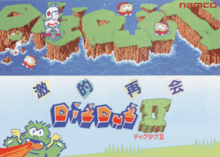Dig Dug II
Dig Dug II[lower-alpha 1] is a 1985 action puzzle arcade game developed and published in Japan by Namco.
| Dig Dug II | |
|---|---|
 Promotional sales flyer | |
| Developer(s) | Namco |
| Publisher(s) | Namco |
| Series | Dig Dug |
| Platform(s) | Arcade, Nintendo Entertainment System, Famicom Disk System, Sharp X68000, Mobile phone |
| Release | |
| Genre(s) | Action puzzle |
| Mode(s) | Single-player, multiplayer (alternating turns) |
| Cabinet | Upright, tabletop |
| Arcade system | Namco Super Pac-Man |
Gameplay
Dig Dug II takes place on an island with an overhead view. The goal is to kill all the enemies. There are two types of enemies: Pookas (round red monsters with goggles), which can kill a player by touching him, and Fygars (dragons), which can kill a player either by touching him or breathing fire on him.
Taizo Hori (the player's character) is armed with two weapons. One is an air pump that can inflate enemies until they burst. The other is a jackhammer, which can be used at "fault lines" on the map to create faults in the ground. If both ends of a system of faults reach the water, the ground surrounded by them will sink into the ocean, killing all creatures on it, including Taizo himself if the player is not careful. The points earned from this depend on how many enemies are killed at once. Once three pieces of land have been cut off an island, a bonus vegetable will appear somewhere on what remains of the island, which can be eaten for extra points. When only one, two or (on later rounds) three enemies remain on the island, the enemies will head for the edge of the island and jump into the water, killing themselves and ending the round.
Reception
| Reception | ||||||||||
|---|---|---|---|---|---|---|---|---|---|---|
| ||||||||||
Dig Dug II was largely unsuccessful, and was not nearly as popular as its predecessor when it was released.[3] The game's departure from the original's maze-chase gameplay, its time of release, and the lack of the original's free movement are believed to have attributed to its failure.[5][6] A reviewer for the magazine Computer & Video Games said that the game, while having a high difficulty level, was worth playing and became easier through practice.[7]
Legacy
In 2005, Dig Dug II was ported to the PlayStation Portable as part of Namco Museum Battle Collection, and was included in Namco Museum DS which was released for the Nintendo DS on September 18, 2007. The game was also included in Namco Museum Virtual Arcade in 2008 and was released on the Wii Virtual Console in Japan on October 20, 2009, along with the inceptive title. Both Dig Dug games are available as part of the Namco Museum Megamix compilation for the Wii, which (much unlike the Virtual Console Arcade versions) was only released in North America.
A reimagined version for PC titled Dig Dug Island, featuring online multiplayer, was released in 2008 exclusively in Japan. However, the game's servers were shut down in just under a year, leaving it unplayable.
References
- Akagi, Masumi (13 October 2006). ナムコ Namco. アーケードTVゲームリスト 国内•海外編 (1971-2005) (in Japanese) (1st ed.). Amusement News Agency. p. 52. ISBN 978-4990251215.
- Baize, Anthony (1998). "Dig Dug II - Review". AllGame. All Media. Archived from the original on 15 November 2014. Retrieved 15 June 2020.
- van Duyn, Marcel (19 October 2015). "Dig Dug II Review (Wii U eShop / NES)". Nintendo Life. Gamer Network. Archived from the original on 12 November 2018. Retrieved 15 June 2020.
- "5月10日号特別付録 ファミコンロムカセット オールカタログ" (in Japanese) (Volume 7, Issue 9). Tokuma Shoten. Family Computer Magazine. 10 May 1991. p. 78.
- Kalata, Kurt (3 December 2008). "Dig Dug II". Hardcore Gaming 101. Archived from the original on 26 September 2019. Retrieved 15 June 2020.
- Retro Gamer Staff (11 June 2010). "Dig Dug II". Retro Gamer. Imagine Publishing. Archived from the original on 25 September 2015. Retrieved 15 June 2020.
- "Arcade Action - Santa Gets Nasty" (47). Future Publishing. Computer & Video Games. September 1985. p. 119. Retrieved 15 June 2020.